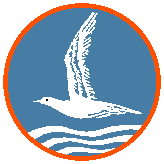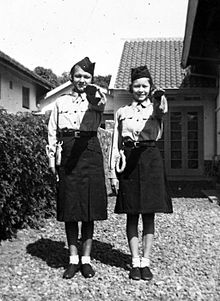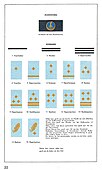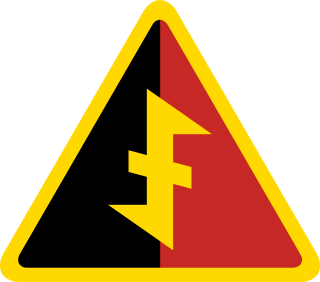
The National Socialist Movement in the Netherlands was a Dutch fascist and later Nazi political organisation that eventually became a political party. As a parliamentary party participating in legislative elections, the NSB had some success during the 1930s. Under German occupation, it remained the only legal party in the Netherlands during most of the Second World War.

Anton Adriaan Mussert was a Dutch politician who co-founded the National Socialist Movement in the Netherlands (NSB) in 1931 and served as its leader until the party was banned in 1945. As such, he was the most prominent Dutch fascist before and during World War II. Mussert collaborated with the German occupation government, but was granted little actual power and held the nominal title of Leider van het Nederlandsche Volk from 1942 onwards. In May 1945, as the war came to an end in Europe, Mussert was captured and arrested by Allied forces. He was charged and convicted of treason, and was executed in 1946.

Despite Dutch neutrality, Nazi Germany invaded the Netherlands on 10 May 1940 as part of Fall Gelb. On 15 May 1940, one day after the bombing of Rotterdam, the Dutch forces surrendered. The Dutch government and the royal family relocated to London. Princess Juliana and her children sought refuge in Ottawa, Canada until after the war.

Cornelis "Kees" van Geelkerken was a Dutch fascist political leader and Nazi collaborator.

The Dutch resistance to the Nazi occupation of the Netherlands during World War II can be mainly characterized as non-violent. The primary organizers were the Communist Party, churches, and independent groups. Over 300,000 people were hidden from German authorities in the autumn of 1944 by 60,000 to 200,000 illegal landlords and caretakers. These activities were tolerated knowingly by some one million people, including a few individuals among German occupiers and military.
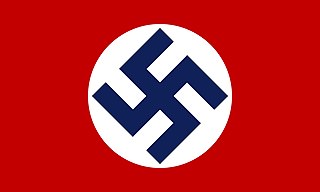
The National Socialist Dutch Workers Party was a minor Dutch Nazi party founded in 1931 and led by Ernst Herman van Rappard. Seeking to copy the fascism of others, notably Adolf Hitler, the group failed to achieve success and was accused by rivals such as the National Socialist Movement in the Netherlands (NSB) and the General Dutch Fascist League of being too moderate for a fascist movement.
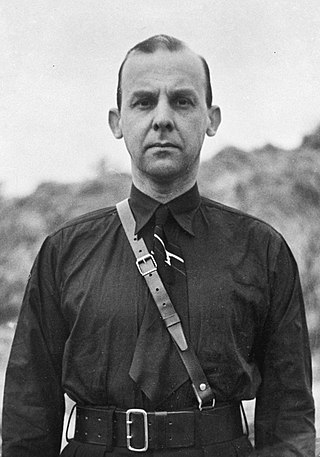
Meinoud Marinus Rost van Tonningen was a Dutch politician of the National Socialist Movement (NSB). During the German occupation of the Netherlands in World War II, he collaborated extensively with the German occupation forces. He was the husband of Florentine Rost van Tonningen.

Johannes Hendrik Feldmeijer was a Dutch Nazi politician and a member of the NSB. He was the commander of the Sonderkommando-Feldmeijer death squad during Operation Silbertanne.

The Reichskommissariat Niederlande was the civilian occupation regime set up by Germany in the German-occupied Netherlands during World War II. Its full title was the Reich Commissariat for the Occupied Dutch Territories. The administration was headed by Arthur Seyss-Inquart, formerly the last chancellor of Austria before initiating its annexation by Germany.
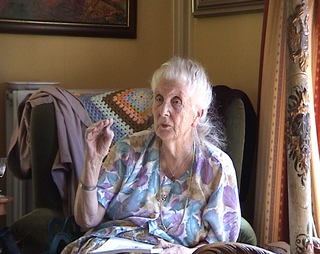
Florentine Sophie Rost van Tonningen was the wife of Meinoud Rost van Tonningen, the second leader of the National Socialist Movement in the Netherlands (NSB) and President of the National Bank during the German occupation (1941–1945). Because she continued to support and propagate the ideals of Nazism after World War II and the death of her husband, she became known in the Netherlands as the "Black Widow".

Henriette Nanette "Jetty" Paerl was a Dutch singer and resistance member of Jewish origin. She is known for being one of the Netherlands' representatives in the Eurovision Song Contest 1956 with the song "De vogels van Holland", and for being the first singer ever to perform in the Eurovision Song Contest.
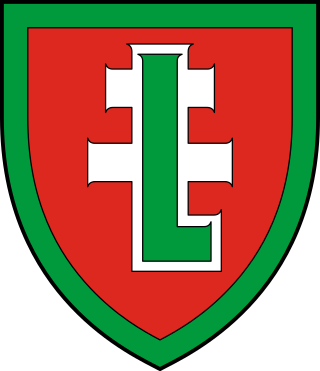
Levente Associations or simply levente were paramilitary youth organizations in Hungary during the interwar period and the Second World War. They were established in 1921 with the declared purpose of physical and health training. As of the mid-1930s, they became a de facto method of circumventing the ban on conscription imposed on Hungary by the Treaty of Trianon and over time, openly became a paramilitary organization under the leadership of military veterans. As of 1939, under the Act of Defense, all boys aged 12–21 were required to join the levente.
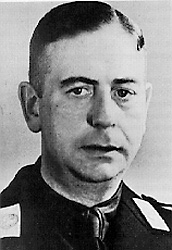
Jonkheer Daniël de Blocq van Scheltinga was a Dutch Nazi politician.
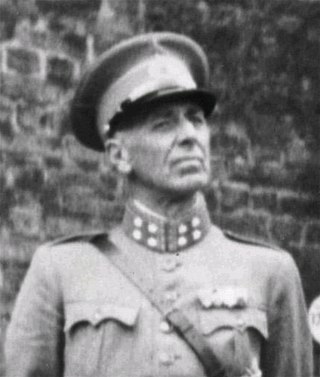
Hendrik Alexander Seyffardt was a Dutch general, who during World War II collaborated with Nazi Germany during the occupation of the Netherlands, most notably as a figurehead of the Dutch Legion, a unit of the Waffen-SS on the Eastern Front.
The Stichting Oud Politieke Delinquenten was a Dutch right-wing organization founded by and for formerly jailed and convicted war criminals, who had collaborated with the German occupiers during World War II. The SOPD was the first and the largest of the collaboratist organizations in the country, “numbering perhaps a hundred former internees.”

Hendrik Evert Koot was a Dutch collaborator with the German occupying forces during World War II. A member of the WA, the paramilitary wing of the National Socialist Movement in the Netherlands (NSB), he was beaten up by members of a local knokploeg in Amsterdam on 11 February 1941. His injuries were so severe that he died a few days later. His death was seized by the German authorities to start raids in the Jodenbuurt, the Amsterdam Jewish quarters, which in turn led to the February strike. Another element of Nazi retaliation was the installation of a Judenrat in Amsterdam: the Jewish Council of Amsterdam.

The Weerbaarheidsafdeling was the paramilitary arm of the National Socialist Movement in the Netherlands (NSB), the fascist political party that collaborated with the German occupiers of the Netherlands during World War II. The organization, roughly equivalent to the German SA, was founded in 1932 by Anton Mussert, co-founder of the NSB in 1931 and its leader until the end of the war. Members wore and marched in black uniforms and were thus called "blackshirts". In 1933 the Dutch government banned the wearing of uniforms, and the WA was disbanded in 1935 in order to forestall the Dutch government's banning it. In 1940, after the German invasion, the WA became openly active again, and more ruthless than before. They specialized in violent attacks, particularly on the Dutch Jewish population.

Adriaan Nicolaas Johan van Hees was a Dutch actor and member of the National Socialist Movement in the Netherlands (NSB). Van Hees was trained in Amsterdam and Germany, and spent a few years in theater and film. He quit professional acting to join the NSB, giving speeches and overseeing the organization's theater division, arguing that the change he thought necessary in Dutch drama had to come from political revolution. He became depressed and suicidal when he discovered he was part Jewish; still, he tried to join the SS but was denied. After the war, he was banned from the stage for ten years, and sentenced to five years in prison.
The Nederlandse Landwacht was a Dutch paramilitary organization founded by the German occupation forces in Holland on November 12, 1943. It should not be confused with the military volunteer corps 'Landwacht Nederland', which was established in March 1943 and renamed Landstorm Nederland in October, and which became part of the Waffen-SS.
